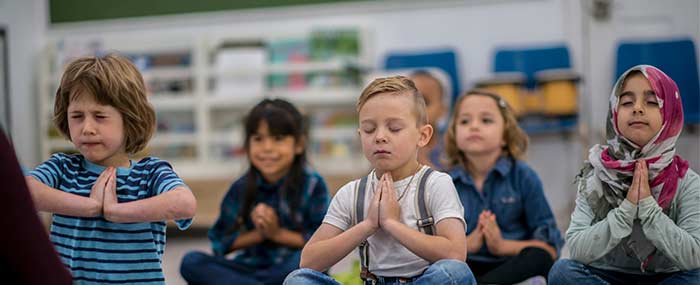Many of us have incorporated various mindfulness practices into our daily lives and into our work with our patients and yet, as with so many other things that are good for you, there is no one-size-fits-all regimen that we can apply.
So how are your colleagues currently adopting mindfulness meditation for their particular client population?
Take a look at Felicia Huppert, PhD, et al. from the Well-Being Institute at the University of Cambridge, UK, who recently published a study in The Journal of Positive Psychology based on the introduction of mindfulness meditation to teenage boys.

Fourteen and fifteen-year old boys, 155 of them in all, from six classes in two British schools were provided training in mindfulness meditation during the course of weekly, 40-minute sessions spread out over one month’s time.
This training included the presentation of mindfulness principles and also practice of mindfulness techniques, such as body and breathing awareness.
Outside of the classroom, the boys were encouraged to listen to 8-minute mindfulness audios and to practice mindfulness exercises each day.
A control sample was created of boys from 5 other classes who attended classes as usual.
The teens completed questionnaires before and after the month-long training and results were compared to that of the boys in the 5 control classes, who attended their normally-scheduled religious classes instead of the mindfulness module.
The results showed that boys completing the mindfulness training had increased levels of well-being (defined here as increased positive emotions, such as contentment, interest and happiness, as well as increased functioning).
Further, the increase in well-being directly correlated to the amount of time a student spent practicing the mindfulness exercises.
This study is limited because of the method used for randomization, but based on the findings of this project, a new 8-week mindfulness module has been introduced into a number of British schools, with modules that are specifically designed for children including “Puppy Training” and “Befriending the Difficult.”
Are you tailoring mindfulness applications to your patient’s particular circumstance and ego strength?
NICABM has brought health and mental health practitioners together to address a full range of mindfulness approaches in our mindfulness programs.
Meanwhile, how do you tailor mindfulness activities for your clients? I invite you to leave a comment below sharing what’s worked for you.
An intriguing discussion may be worth comment. I believe that you can write regarding this topic, it will not be a taboo subject but usually people are insufficient to talk on such topics. To the next. Cheers
I used a free self-help program i found on line and it took some practice, but it worked. The key for me was learning about the effects of adrenalin, and understanding that anxiety symptoms are caused by adrenalin, and that no matter how severe the symptoms might be, there is no actual risk. Fast heart beat, shallow breathing, light headedness, nausea, feeling shaky, and feeling woozy are normal responses to adrenalin. Most of my anxiety was caused by worrying about the effects of anxiety – a viscous circle, but one that was easy to break once i got the whole picture. . . Here’s the link:
My friend and I have been practising mindfulness meditation for years and she has taught it her children at school where she is a teacher. She has been very successful, so much so they have been known to actually request it. She calls it quiet time.
We have also had children as young as 9 come to our meditation group and meditate with us.
Is there any info available on tailoring Mindlfulness training for students with Asperger’s? I would be grateful. Thanks
I have been interested in the possibilities of mindfulness for children for some time. This article makes me realize that using mindfulness with children is simply an extension of the larger issue of tailoring mindfulness to the psychological/emotional developmental level of an individual, regardless of their age. I am excited about the new teleseminar series and hope to learn more about tailoring mindfulness to the individual in the weeks to come.
My colleague, Pam Siegel, and I have an mindfulness meditation support group for girls with eating disorders. We use a mindfulness meditation to start the group and then process. The girls that have incorporated the mindfulness practice into their lives have truly benefited from the practice.
It’s really interesting that children are learning mindfulness and that there is research showing it’s effectivness. I would like to learn more, espically is there has been research done with health professionals who are feeling overwhelmed and stressed.
You could definitely see your etxpreise in the paintings you write. The arena hopes for even more passionate writers such as you who are not afraid to say how they believe. At all times go after your heart. Experience is a good school, but the fees are high. by Heinrich Heine.
I also do mindfulness work with children and caregivers and have seen wonderful results! The youngest child to whom I’ve offered mindfulness was only 3… for this age group it seems critical that mindfulness be tailored to the particular child and his or her need in that moment. I’ve found very little success offering mindfulness in any kind of structured or pre-planned way with these little ones – instead of take advantage of teachable moments, like a week ago when a 3-year old child was having some intense separation anxiety from his mother and I invited him to notice his breathing as a way to self-soothe… recently I learned some wonderful mindfulness songs by Betsy Rose that I plan to use as well, and there are some great books out there that can be used as aids with these little guys… anyway, just wanted to comment on mindfulness with children and how we really do need to make things developmentally appropriate and tailored to our audiences! 🙂